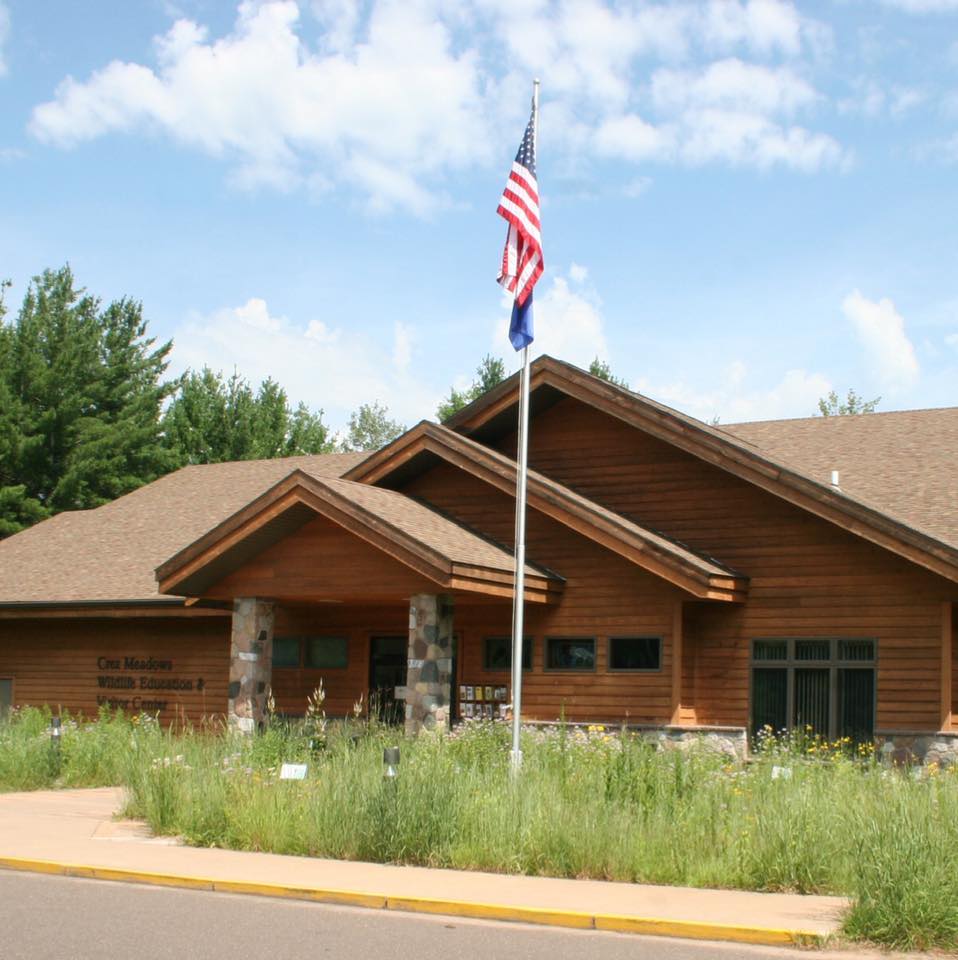Crex Meadows Wildlife Area Visitor & Education Center 
Conveniently located at the intersection of County Road D and County Road F, stop in to speak with knowledgeable staff and volunteers to make the most of your visit. Center hours vary from season to season so be sure to check the current hours of operation at the bottom of this page.
Wildlife & Historical Displays
Inside the center, visitors can view historical displays about Crex Meadows. Visitors can also view a variety of educational taxidermy. Maps, checklists, and more can also be found inside the center!
Equipment Rentals
Visitors that forget to bring along their trusty binoculars are not out of luck! Visitors can rent binoculars for $5 - or for free with a Friends of Crex membership. We also have snowshoe rentals available for the same price in the wintertime.


Driving Tour
The tour route is 24-miles long. Drive slowly, about 15-20 mph. Look and listen for wildlife. Most animals are secretive and will go unnoticed if you don't watch carefully. Look for the numbered Auto Tour signs. Stop and read the corresponding description in this guide. You can also follow the arrows marked on the map on pages 10-11. Have a pleasant drive.

Archery Course
Crex Meadows Archery Course is located on the trail behind the Crex Meadows Wildlife Education & Visitor Center. With (20) bale targets, (20) 3D targets, (2) large box targets and (3) elevated shooting platforms, all skill levels are welcome. 3D targets are available during events and scheduled dates only.
Recreation 
Bird Watching
Crex Meadows is listed as one of the top 500 birding spots to visit in the United States. There are over 280 species that use the property, and many are seen consistently each year. Stop by the visitor’s center for up-to-date bird sighting information.
Hunting and Trapping
Many people enjoy the area for hunting and trapping, which is allowed on all three Glacial Lake Grantsburg wildlife areas.
Kayaking and Canoeing
If you're looking for a new wildlife viewing experience in Crex Meadows, try kayaking or canoeing on one of our flowages.
Biking
Bring your bike to Crex Meadows for a quieter way to explore the area.
Wildflowers
Crex Meadows is host to a wide variety of wildflowers, all of which bloom at different times. You never know what wildflowers you might find on your next visit!
Snowshoeing
Pass the long winter days at Crex Meadows and view winter wildlife from your snowshoes.
Wildlife Viewing
Other than birds, there are a variety of species of mammals, reptiles, amphibians and insects that visitors can view throughout the properties.
Hiking
Several hiking trails are offered on Crex Meadows for visitors to enjoy. They vary in length, ranging from about 1 mile to 3.5 miles, but all are easy to walk. Stop by the visitor center and get a trail map before you begin!
Camping
From September 1 to December 31, visitors can camp at the rest area at Crex Meadows. It is a great option for those who hunt on the property, but it can also be an exciting experience for early-rising wildlife watchers and photographers.
Animal Tracking
Are you looking for a new way to experience wildlife? You're in luck! Crex Meadows, Fish Lake and Amsterdam Sloughs are great places to look for animal tracks. Get off the beaten path and see what you can find.
Wildlife Photography
Crex Meadows is an excellent place for wildlife photography. There is a wide variety of wildlife and landscape throughout every season for photography enthusiasts to capture.

History of Crex Meadows 
The famous marshes and large, sandy plains of Crex Meadows were created from a retreating glacier over 13,000 years ago. The wildlife area is part of a larger system known as the Northwest Wisconsin Pine Barrens which extends from northern Polk County to southern Bayfield County.
The mid-1800s brought settlers who tried farming the sandy soil with not much success.
Large-scale drainage of wetlands in the 1890s, caused a decline in the number of nesting and migrant waterfowl and other wetland animals.
In 1912, the Crex Carpet Co., an eastern corporation that produced grass rugs, purchased 23,000 acres in the location we now know as Crex Meadows. When linoleum floor covering became popular, the Crex Carpet Co. went bankrupt in 1933 but the name Crex remained. After a series of failed drainage and agricultural attempts, the state of Wisconsin purchased 12,000 acres to start the Crex Meadows Wildlife Area. Today, Crex Meadows sees over 100,000 visitors a year who enjoy the refuge for hunting, trapping and recreational use.
Frequently Asked Questions
Contact Us
We would love to hear from you!
Visitor Center Hours
Closed most holidays.
SPRING (April-Mid June)
Weekdays: 8:00 am-4:30 pm
Weekends: 10:00 am- 4:00 pm
SUMMER (Mid June-Labor Day)
Weekdays: 8:00 am- 4:30 pm
Weekends: 10:00 am-4:00 pm
FALL (Labor Day-October 31st)
Weekdays: 8:00 am- 4:30 pm
Weekends: 10:00 am- 4:00 pm
WINTER (November-March)
Weekdays: 8:00 am-4:30pm
Weekends: CLOSED